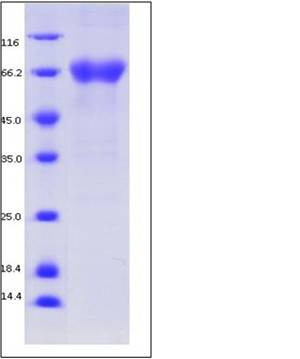Human TIM-3 / HAVCR2 Protein (His & Fc Tag)
CD366,HAVcr-2,HAVCR2,KIM-3,Tim-3,TIM3,TIMD-3,TIMD3
- 100ug (NPP4314) Please inquiry
| Catalog Number | P10390-H03H |
|---|---|
| Organism Species | Human |
| Host | Human Cells |
| Synonyms | CD366,HAVcr-2,HAVCR2,KIM-3,Tim-3,TIM3,TIMD-3,TIMD3 |
| Molecular Weight | The recombinant human TIMD3/Fc is a disulfide-linked homodimer after removal of the signal peptide. The reduced monomer consists of 426 amino acids and has a predicted molecular mass of 47.7 kDa. In SDS-PAGE under reducing conditions, the apparent molecular mass of rhTIMD3/Fc monomer is approximately 66 kDa due to glycosylation. |
| predicted N | Ser 22 |
| SDS-PAGE |  |
| Purity | > 88 % as determined by SDS-PAGE |
| Protein Construction | A DNA sequence encoding the human TIMD3 (NP_116171.3) extracellular domain (Met 1-Arg 200) was fused with the C-terminal polyhistidine-tagged Fc region of human IgG1 at the C-terminus. |
| Bio-activity | |
| Research Area | Cancer |Signal transduction |Metabolism |Types of disease |Metabolism in Diabetes |
| Formulation | Lyophilized from sterile PBS, pH 7.4 1. Normally 5 % - 8 % trehalose and mannitol are added as protectants before lyophilization. Specific concentrations are included in the hardcopy of COA. |
| Background | Hepatitis A virus cellular receptor 2 (HAVCR2), formerly known as T cell immunoglobulin and mucin domain-3 (TIM-3), is a transmembrane glycoprotein expressed on the surface of terminally differentiated Th1 cells but not on Th2 cells. It was the first surface molecule that specifically identifies Th1 cells in both mice and human. Recently, identification of Galectin-9 as a ligand for TIM-3 has established the TIM-3-Galectin-9 pathway as an important regulator of Th1 immunity and tolerance induction. Engagement of Tim-3 by its ligand galectin-9 negatively regulates IFN-gamma secretion and influences the ability to induce T cell tolerance in both mice and man. It suggests a novel paradigm in which dysregulation of the TIM-3-galectin-9 pathway could underlie chronic autoimmune disease states, such as multiple sclerosis. Recent work has explored the role of TIM-3 in systemic lupus erythematosus (SLE), and their results indicate that TIM-3 may represent a novel target for the treatment of SLE. Numerous studies have demonstrated that Tim-3 influences autoimmune diseases, including diabetes and multiple sclerosis, and its role in other inflammatory diseases including allergies and cancer is beginning to become clear. In tumor rejection model, soluble form of Tim-3 (sTim-3) significantly impaired T cell antitumor immunity, evidenced by decreased antitumor CTL activity and reduced amount of tumor-infiltrating lymphocytes in tumor. sTim-3 as an immunoregulatory molecule that may be involved in the negative regulation of T cell-mediated immune response. |
| Reference |
